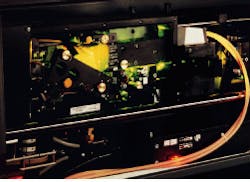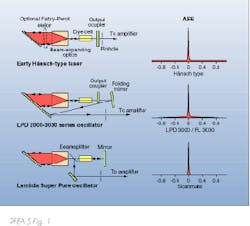Oscillator design improves dye-laser performance
JEFFREY BERNSTEIN, UWE STAMM, and PETER GENTER
Since their development in the mid-1960s, pulsed dye lasers have been the preferred light sources for a diverse group of applications including spectroscopy, biomedicine, photochemistry, photophysics, and remote sensing. They offer a unique combination of wavelength tunability, high pulse energy, and high peak power. The wavelength tuning allows precise excitation of resonant phenomena in atoms and molecules. The high power and pulse energy are particularly critical for applications with inherently weak signals, such as those involving nonlinear or multiphoton processes. Unfortunately, though, these lasers have often had problems of spectral purity due to a phenomenon known as amplified spontaneous emission (ASE).
Recent years have seen the development of higher-energy excimer and Nd:YAG pump lasers for dye lasers. This combination enables the detection of weaker signals in such applications as remote sensing. High-energy pump lasers tend to degrade the spectral purity of the dye-laser output, yet for many applications a high-quality, spectrally pure laser source is critical. A different approach to dye-laser oscillator design has now successfully addressed this problem. Specifically, this design naturally eliminates most ASE. As a result, the spectral purity of the lasers that incorporate this oscillator is more than an order of magnitude better than that from any previous design.
Dye lasers and ASE
To understand ASE, first one needs to consider the operational principles of a pulsed dye laser (see Fig. 1, top). The gain medium is a flow cell containing dye solution, or a solid matrix doped with dye, that is irradiated by the focused pulse from a pump laser. Control of laser-output wavelength is achieved by placing the oscillator dye cell in a cavity defined by an output mirror and a diffraction grating. As originally discovered by T. Hänsch, a beam-expanding telescope (usually 20X–25X) in the cavity serves two important purposes. First, it spreads the oscillator beam over more of the grating, resulting in a narrower bandwidth (wavelength spread). Second, the telescope collimates the beam (making it 20 to 25 times more parallel), which also reduces bandwidth, as well as enabling the use of an optional Fabry-Perot etalon for further wavelength narrowing. In most pulsed dye lasers, the output of this narrow-linewidth oscillator is subsequently amplified in one or more amplifier stages; these consist of dye cells irradiated by part of the pump laser beam. Most of the pump-laser power is directed into the amplifiers.The pump source originally used for this type of laser was a nitrogen laser at 337 nm. Because of its low power, the nitrogen laser was soon superseded by excimer lasers (308 and 351 nm) and Nd:YAG lasers (532 and 355 nm). Their relative efficiencies peak in different wavelength regions, but the use of frequency-mixing and frequency-doubling schemes now allows either excimer- or Nd:YAG-pumped dye lasers to be used at essentially any wavelength of interest between the deep-UV and near-IR spectral regions.
As a result, pulse duration and repetition rate, rather than wavelength, are now the important issues in the choice of a pump laser. Excimer lasers can operate at repetition rates of greater than 500 Hz, whereas most Nd:YAG lasers operate in the 10-50-Hz range. Excimer lasers therefore facilitate faster data acquisition because of the higher repetition rate.
In terms of pulsewidth, a typical excimer laser generates 10-30-ns pulses, whereas a frequency-doubled or frequency-tripled Nd:YAG laser generates pulses in the 2–8-ns range. For the same pulse energy, Nd:YAG-laser pumping therefore produces higher peak powers, which can be very important for detecting weak signals or if the dye beam is to be doubled, mixed, or shifted in some nonlinear process. Shorter pulses, however, usually mean greater ASE—an undesirable artifact of many pulsed dye lasers.
ASE arises because of the combination of high peak power and short pulse lengths in pulsed dye lasers. The emission curve of laser dyes is quite broad, sometimes covering tens of nanometers. Without the wavelength control provided by multiple passes off the diffraction grating, the dye would emit broadband radiation over the available gain bandwidth.
When the pump laser pulse first starts to irradiate the dye cell, broadband emission occurs until the retroreflection from the grating acts as a seed to control further emission as narrow-bandwidth stimulated emission. This initial broadband emission is referred to as "prompt ASE." However, because of the high peak power and, hence, high gain in the dye cell, the dye may continue to produce additional ASE throughout the duration of each pulse. This decreases as the number of passes the laser pulse makes around the oscillator cavity increases; generally, CW lasers do not produce ASE. For these reasons, pumping a given laser with the short (<8 ns), high-peak-power pulses from a typical Nd:YAG laser leads to a higher level of ASE than using the longer pulses from an excimer laser.
Because an amplifier dye cell will amplify this ASE at least as efficiently as it amplifies the true laser light, the spectral purity of the final amplified output beam is critically dependent on the amount of ASE generated in the oscillator stage. Of course, in an amplifier dye cell, a minute amount of unamplified ASE may also be generated. This is easily minimized by use of a pump-laser optical delay line; the pump pulse does not begin to excite the amplifier dye until it is seeded by the narrow-bandwidth output of the oscillator. As a result, the dominant contribution to overall laser ASE is that which originates in the oscillator.
In some pulsed-laser applications, ASE can be a limiting factor. In remote sensing of molecules, for example, quantitative detection requires that the laser source only detect a specific rotational line in the spectrum. Broadband emission could lead to weak excitation of an entire spectral band.
Designs to reduce ASE
Over the past 15 years, several schemes have been employed in commercial lasers to eliminate oscillator ASE and, hence, improve spectral purity. Early dye lasers simply used a pinhole orifice between the oscillator and amplifier. This cuts down the ASE somewhat, because the ASE is less collimated than the true laser light beam .
A significant improvement was introduced nearly 15 years ago in the Lambda Physik 2000 dye laser series. This model used the grating to "refilter" the oscillator output before it reached the amplifier or preamplifier dye cells. The principle is very simple—the optical path of the oscillator is folded so that the output beam is reflected off part of the grating before passing through an exit aperture (see Fig. 1, middle). The result was an order of magnitude decrease in ASE, relative to conventional Hänsch-type designs. For some Nd:YAG-laser-pumped applications, however, even these low ASE levels caused problems.
The ratio of pulse length to the oscillator cavity round-trip time really determines the amount of ASE. An alternative approach, therefore, would be to reduce the length of the oscillator cavity—that is, the distance from the output-coupler mirror to the grating. This approach is impractical beyond a certain limit because of operational and geometrical constraints and the physical size of the cavity components. Another approach that we developed at Lambda Physik (Acton, MA) is to remove the ASE from the oscillator output by using an unusual output-coupling scheme.
Our earlier design had used the grating to refilter the output beam, but this beam covered only a small area of the grating. As a result, the grating acted only as a moderately narrow filter. The Lambda Super Pure oscillator directly intercepts the intracavity light reflected from the grating and directs part of this through the output coupler (see Fig. 1, bottom). Although shown as a simple beamsplitter for clarity in the figure, this out-coupling technique actually uses internal reflection from a prism in the beam-expanding telescope to avoid unnecessary cavity losses.The advantages of this design are obvious. Prompt ASE is completely eliminated, and only light that has been reflected off the full aperture of the grating is out-coupled. The im provement in performance is dramatic: more than an order of magnitude decrease in ASE is observed, relative to the best previous design. Even with Nd:YAG pump pulses as short as 2–3 ns, this oscillator produces less than 10-4 ASE (see Fig. 2).
The improved oscillator is now a part of all our company’s Scanmate dye laser systems (see photo at top of this page). These are the first high-performance dye lasers that are truly compatible with all excimer, Nd:YAG, and copper-vapor pump lasers. In addition, the narrow linewidth and high spectral purity of the Super Pure oscillator have enabled successful development of another type of tunable source, the Scanmate OPPO—an optical parametric power oscillator tunable throughout the visible and near-infrared (400 nm–2.5 µm) wavelength ranges. Applications in spectroscopy, remote sensing, and photochemistry and photophysics will benefit from these sources.


